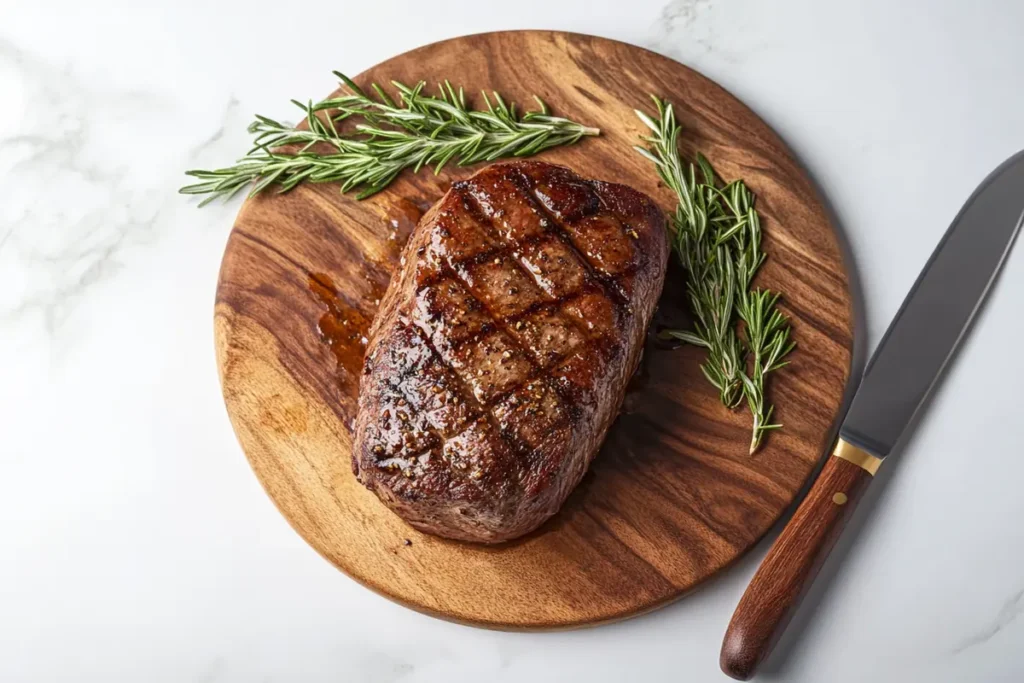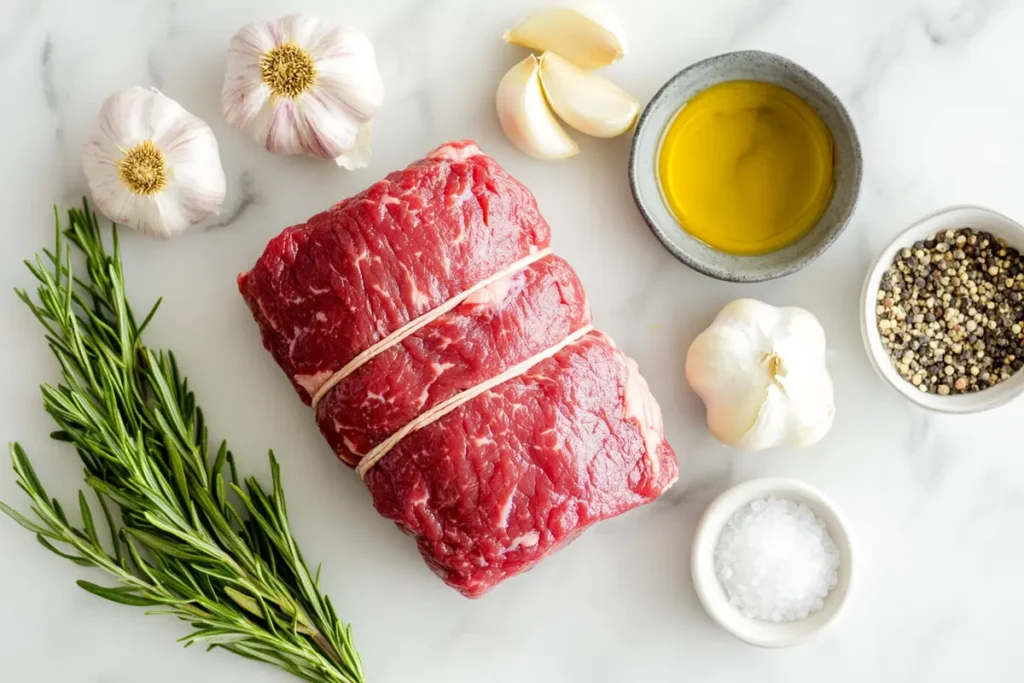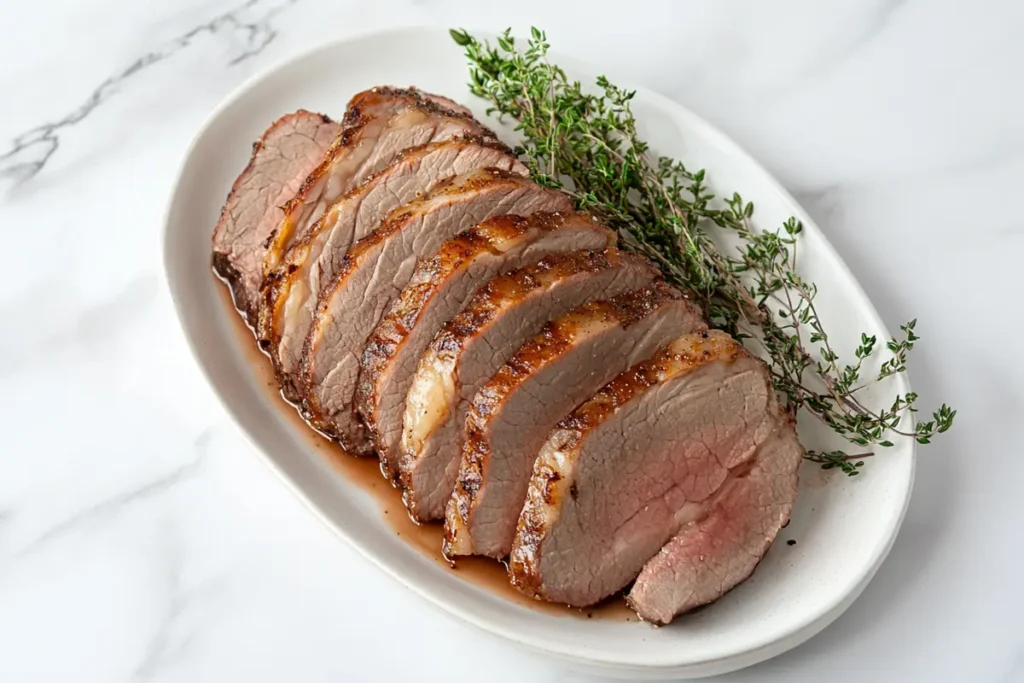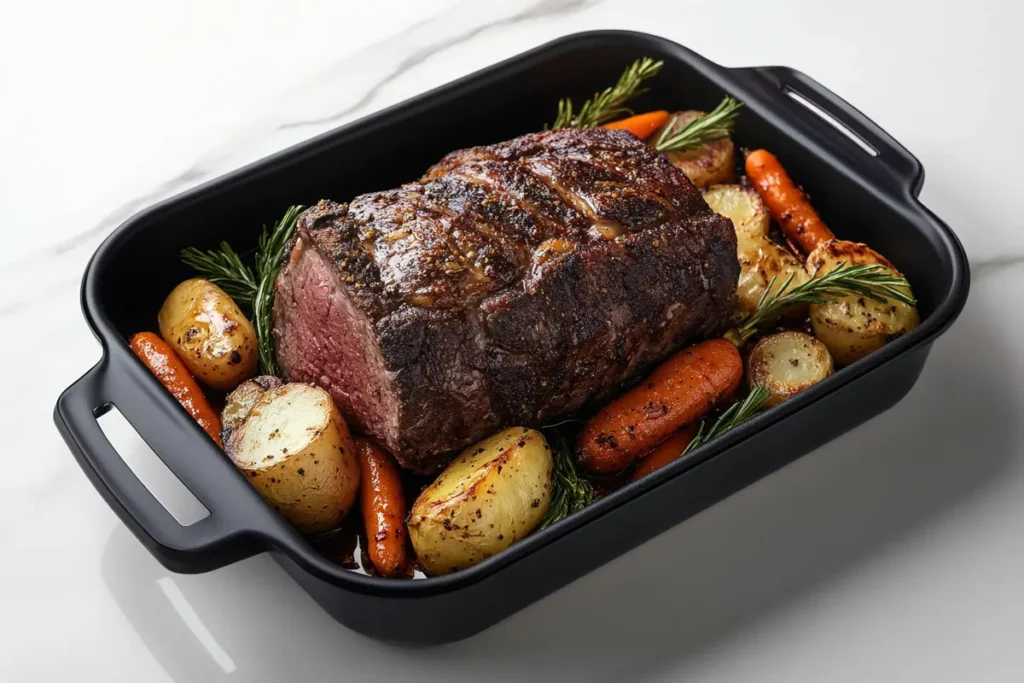
Bottom Round Roast Recipe: A Step-by-Step Guide for a Delicious Roast
Bottom round roast is a classic cut of beef that’s both flavorful and budget-friendly. With the right preparation, this roast can be transformed into a tender, juicy dish ideal for family dinners, holidays, or even meal prep. Moreover, in this article, we’ll explore everything you need to know about this versatile cut, from what it is to how to cook it perfectly. In addition, we’ll share tips, tricks, and nutritional insights to help you master the bottom round roast recipe. So, let’s dive in!
What is a Bottom Round Roast?
Understanding the Bottom Round Cut
The bottom round roast comes from the back leg of the cow, a well-exercised area that produces lean, flavorful cuts of meat. While it’s not as tender as premium cuts like ribeye or tenderloin, it’s prized for its robust beefy flavor and affordability.
Why is it called “bottom round”? The name refers to its location—it’s part of the “round” primal cut, specifically from the bottom section of the round. This makes it leaner than the top round but still full of potential when prepared correctly.
Key features of the cut:
- Lean and low in fat
- Ideal for slow cooking or roasting
- Budget-friendly option for large gatherings
Why Choose Bottom Round for Roasting?
Despite being lean, the bottom round roast can turn out incredibly tender and juicy when cooked properly. Here’s why it’s a popular choice:
- Versatility: You can roast it, slow-cook it, or even slice it thin for sandwiches.
- Cost-effectiveness: It’s a great choice for feeding a crowd without breaking the bank.
- Flavor-packed: With the right seasonings and cooking method, this roast delivers rich, savory goodness.
Pro Tip: Always slice your roast thinly against the grain to maximize tenderness and make each bite melt in your mouth.

Ingredients for the Perfect Bottom Round Roast Recipe
The secret to a perfect bottom round roast recipe lies in the quality and balance of its ingredients. Each component contributes to the roast’s flavor, tenderness, and overall appeal.
Essential Ingredients and Their Roles
Here’s what you’ll need:
- Bottom round roast (3-4 lbs): The star of the recipe, this cut offers a lean, beefy flavor perfect for roasting or slow cooking.
- Olive oil (2 tbsp): Adds moisture and helps the seasonings adhere to the roast.
- Garlic cloves (4, minced): Infuses the roast with a deep, savory flavor.
- Fresh rosemary and thyme (2 sprigs each): Enhances the aroma and complements the beef’s natural taste.
- Salt and black pepper (to taste): Basic seasonings that bring out the roast’s flavor.
- Onion (1 large, sliced): Creates a flavorful base for roasting.
- Beef broth (1 cup): Keeps the roast moist during cooking.
- Optional vegetables: Carrots, potatoes, or celery for a one-dish meal.
Optional Add-Ins for Enhanced Flavor
Want to elevate your bottom round roast recipe? Try these add-ins:
- Paprika or smoked paprika: Adds warmth and a slight smoky kick to the seasoning.
- Worcestershire sauce (1 tbsp): Deepens the flavor profile of the roast.
- Red pepper flakes: For a hint of spice.
Substitutions for Dietary Needs
- Low-sodium broth: Use this instead of regular beef broth to reduce sodium.
- Herb alternatives: If fresh rosemary and thyme aren’t available, dried herbs work too—use half the amount.
- Oil alternatives: Substitute olive oil with avocado oil for a healthier option.
For inspiration on ingredient flexibility, check out the Carrot Walnut Cake Recipe for ideas on customizing classic dishes.

How to Cook a Bottom Round Roast: Step-by-Step Recipe
Cooking a bottom round roast recipe to perfection requires a bit of patience, but the results are well worth the effort. Follow this step-by-step guide for a juicy, flavorful roast every time.
Preparation: Tools and Equipment Needed
Before you start, gather these tools:
- Roasting pan or Dutch oven
- Meat thermometer
- Cutting board and sharp knife
- Basting brush
Prepping the Roast
- Remove the roast from the fridge and let it sit at room temperature for 30 minutes.
- Pat the roast dry with paper towels to ensure a good sear.
- Rub the entire surface with olive oil, minced garlic, salt, and pepper.
Searing the Roast
- Heat a large skillet over medium-high heat.
- Sear the roast on all sides for 2-3 minutes per side until golden brown. This locks in juices and adds flavor.
- Transfer the roast to a roasting pan or Dutch oven.
Cooking the Roast
Oven Roasting:
- Preheat the oven to 325°F (165°C).
- Arrange sliced onions, rosemary, and thyme around the roast.
- Pour beef broth into the pan to keep the roast moist.
- Cover with a lid or foil and roast for 1.5 to 2 hours, or until the internal temperature reaches 135°F (for medium-rare).
Slow Cooking:
- Place the roast in a slow cooker with onions, carrots, and potatoes.
- Add garlic, rosemary, and thyme, then pour beef broth over the top.
- Cook on low for 6-8 hours or until tender.
Step 4: Resting and Slicing for Perfect Results
- Let the roast rest for 15-20 minutes after cooking to retain juices.
- Slice thinly against the grain to ensure each piece is tender and easy to chew.
Nutritional Information for Bottom Round Roast
Knowing the nutritional profile of a dish is key to enjoying it while staying on track with your dietary goals. The bottom round roast recipe is a lean, protein-packed option that fits well into many meal plans.
Nutritional Benefits of Bottom Round Roast
A bottom round roast is naturally lean and low in fat, which makes it a healthier alternative to fattier cuts. Furthermore, it’s rich in protein, thereby supporting muscle growth and repair. Additionally, it contains essential vitamins and minerals like iron, zinc, and B12, all of which contribute to overall health. Additionally, its high protein content helps keep you feeling full longer.
For those seeking a low-carb meal, this roast is an excellent choice since it contains virtually no carbohydrates. Pairing it with nutrient-dense sides, such as roasted vegetables or a fresh salad, creates a balanced and satisfying dish.
HTML Table of Nutritional Content (Per 100g)
Below is a breakdown of the nutritional content of bottom round roast:
| Nutrient | Amount per 100g |
|---|---|
| Calories | 150 |
| Protein | 26g |
| Fat | 5g |
| Carbohydrates | 0g |
| Saturated Fat | 2g |
| Iron | 2.5mg |
| Zinc | 4mg |
| Vitamin B12 | 2.4mcg |
For more recipes that pair perfectly with lean proteins, check out the Carrot Walnut Cake Recipe for a healthy dessert option to round out your meal.
Tips for Cooking the Best Bottom Round Roast
Cooking the best bottom round roast recipe involves more than just following a recipe—it’s about mastering techniques that bring out the cut’s natural flavors and ensure tenderness. These tips will help you achieve mouthwatering results every time.
Achieving Tender and Juicy Results
- Marinate Overnight: If you want extra flavor and tenderness, marinate the roast overnight in a mixture of olive oil, garlic, rosemary, and a splash of soy sauce.
- Don’t Skip the Sear: Searing locks in the juices and adds a caramelized crust that enhances the roast’s flavor.
- Rest Before Slicing: Always let the roast rest for 15-20 minutes after cooking. This step redistributes the juices, making every slice moist and flavorful.
How to Adjust Cooking Times for Different Preferences
- For medium-rare: Cook until the internal temperature reaches 135°F.
- For medium: Aim for an internal temperature of 145°F.
- For well-done: Cook to 160°F, though this may reduce tenderness slightly.
Using a meat thermometer ensures accuracy and prevents overcooking.
Pairing Ideas: Sides and Sauces
Pair your bottom round roast recipe with these sides and sauces for a complete meal:
- Sides: Garlic mashed potatoes, roasted Brussels sprouts, or buttered green beans.
- Sauces: A rich beef gravy, horseradish cream, or a simple au jus.
For more delicious recipes to complement your meal, explore our Pumpkin Pie Cinnamon Rolls for a sweet finish to your feast.
FAQs About Bottom Round Roast
Making a bottom round roast recipe often raises questions, especially for first-time cooks. Here are answers to some of the most commonly asked questions to help you achieve perfect results.
How Do I Keep a Bottom Round Roast Tender?
Keeping a bottom round roast tender involves a few essential steps:
- Low and Slow Cooking: Cooking at a low temperature for a longer time helps break down the meat’s fibers, resulting in a tender texture.
- Use a Marinade: A marinade with acidic ingredients like lemon juice or vinegar can help tenderize the meat before cooking.
- Resting the Meat: After cooking, let the roast rest for at least 15 minutes to allow the juices to redistribute evenly.
Can I Use a Marinade for Bottom Round Roast?
Yes, marinades are an excellent way to enhance the flavor and tenderness of a bottom round roast recipe. Here’s a simple marinade idea:
- Ingredients: Olive oil, soy sauce, garlic, fresh rosemary, and a splash of lemon juice.
- How to Use It: Coat the roast evenly with the marinade, then let it sit in the fridge for 8-12 hours. This step infuses the meat with bold flavors while improving its texture.
What’s the Best Cooking Method for Bottom Round Roast?
The best method depends on your preferences and tools:
- Oven Roasting: Great for a crispy exterior and medium-rare center.
- Slow Cooking: Ideal for a fall-apart tender roast, especially when paired with vegetables.
- Pressure Cooking: A faster option that still delivers tender results.
How Do I Know When My Bottom Round Roast is Done?
The best way to check doneness is by using a meat thermometer:
- Medium-Rare: 135°F
- Medium: 145°F
- Well-Done: 160°F
Conclusion: Mastering the Art of Bottom Round Roast
Why Bottom Round Roast is Worth the Effort
Cooking a bottom round roast recipe might seem intimidating at first, but it’s a skill worth mastering. This lean, flavorful cut is not only perfect for feeding a crowd but also ideal for preparing meals for the week. Moreover, its versatility makes it a go-to choice for everything from casual family dinners to holiday feasts.
Encouraging Readers to Try the Recipe
If you’re looking for a dish that’s hearty, satisfying, and easy on the wallet, then the bottom round roast recipe is your answer. With just simple ingredients and a few cooking techniques, you can create a meal that’s both impressive and delicious. Therefore, why not give it a try? Who knows, your next family dinner might just become a new favorite tradition.
Common Mistakes to Avoid When Making Bottom Round Roast
Cooking a bottom round roast recipe can be easy, but a few common mistakes might affect your results. By understanding these pitfalls, you can avoid them and ensure a perfect roast every time.
Skipping the Sear
One of the most common mistakes is skipping the sear. Searing the roast before cooking locks in the juices and creates a flavorful crust. For best results, heat a skillet over medium-high heat, and sear all sides of the roast for 2-3 minutes before transferring it to the oven or slow cooker.
Cooking at Too High a Temperature
High cooking temperatures can dry out the roast and make it tough. Instead, opt for low and slow cooking, whether you’re roasting in the oven or using a slow cooker. Maintaining a temperature of around 325°F for oven roasting ensures even cooking and tenderness.
Not Resting the Meat
Skipping the resting period after cooking can result in dry slices. Resting allows the juices to redistribute throughout the meat, making each slice juicy and flavorful. Always let the roast rest for at least 15-20 minutes before slicing.

Variations and Creative Twists for Your Bottom Round Roast Recipe
The bottom round roast recipe is already delicious on its own, but adding a personal touch can make it even more exciting. Here are a few creative variations to try:
Herb-Crusted Bottom Round Roast
Elevate your roast with a flavorful herb crust:
- Combine minced garlic, rosemary, thyme, parsley, salt, and pepper.
- Coat the roast with olive oil, then press the herb mixture onto the surface.
- Roast as usual for an aromatic twist.
Bottom Round Roast with Vegetables
Turn your roast into a one-pan meal by adding vegetables:
- To start, arrange carrots, potatoes, and onions around the roast in the pan. Next, drizzle with olive oil, season with salt and pepper, and roast alongside the meat. As a result, the juices from the roast will flavor the vegetables, making them tender and delicious.
Spicy Bottom Round Roast
For a spicier kick, add these steps to your recipe:
- Rub the roast with chili powder, smoked paprika, and a pinch of cayenne pepper.
- Mix Worcestershire sauce into the broth for a deeper flavor.
- Serve with a side of horseradish cream for an extra kick.
Clearly, these variations show how flexible and creative the bottom round roast recipe can be. Whether you choose to keep it classic or add a unique twist, this dish is undoubtedly sure to please. Additionally, let me know if you’d like to add more tips or refinements!
FOR MORE DELICIOUS RECIPES:
How to Make the Best Peach Crumble: A Step-by-Step Guide

